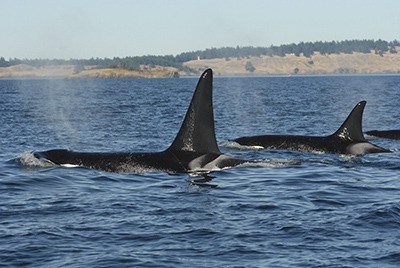What only a few short years ago appeared to be an upswing in the population now seems like fleeting good fortune in the up-again, down-again saga of the southern resident killer whales.
With four members missing and presumed dead, the population has fallen to 80 animals, according to the Center for Whale Research. The population totaled 88 in 2010.
Center Director Ken Balcomb, citing this year’s dismal return of Chinook salmon to the Fraser River, maintains a combination of dwindling food supply and toxic materials accumulated in the blubber of the whales is largely to blame for the latest disappearances and drop in numbers. Without enough prey to satisfy nutritional needs, Balcomb said whales draw on blubber for fuel and that toxins are then released into their circulatory system in highly concentrated levels.
“All whales use blubber as sort of a freezer storage area,” he said. “The PCBs [polychlorinated biphenyls] go from parts per billion to parts per million when they start drawing on the bank account of blubber and just like in humans it affects the immune system, the nervous system, the reproductive system. It’s what happens when you have bad years for fish.”
The center, which maintains a census of the southern resident killer whales for the National Marine Fisheries Service, will list three whales missing in its 2013 survey, all from L-pod. The three are: L-2, a female, estimated age of 53, L-26 a female, estimated age of 57, and L-79 a male born in 1989.
The census does not include J-8, a female whose age the center estimates at 80, and which appears to be the latest casualty.
Also known as “Spieden,” J-8 was not among others members of J-pod when the group showed up en masse about a week ago off the west side of San Juan Island. Center senior research assistant Erin Heydenreich said the 80-year-old female had shown telltale signs of declining health, shrinkage of tissues around head – commonly referred to as “peanut head” – over the past two years, according to the center’s Erin Heydenreich, senior research assistant.
The southern residents consist of three pods, J, K and L. Called “residents” because they spend a majority of the year in the waters of the Salish Sea, they are considered endangered by the U.S. and Canada. Their population, believed to have been historically in the high 100s, was decimated by captures for marine parks, which ended in the 1970s, followed by pollution and declining salmon populations.
The whales’ population plummeted to 71 by 1973, climbed to 99 in 1995, then plummeted to 79 six years later. The population rebounded to 80 in 2002, 83 in 2003, 89 in 2005, and has seesawed around 88 since then. The whales were declared endangered by the U.S. and Canada by 2005.
Some orca advocates insist there’s greater concern for the long-term health of the population than just the decline in overall headcount.
Based on a study of the center’s survey, Orca Relief Citizens’ Alliance cites a sharp decline in the number of breeding-age females and males, down 24 percent since 2004, and 26 percent since 2009, respectively. However, the next generation of breeding females, 3-15 years of age, has fallen even faster, down 39 percent since 2000, according to Orca Relief.
“Our new analysis suggests that the greatest danger to the population is much more serious than indicated by total headcount, as the breeding female population, today and tomorrow, plunges at an alarming rate,” Orca Relief Executive Director Bruce Stedman said in a press release. “We are concerned that if additional protective steps are not taken very soon it could be too late for Puget Sound’s resident Orca.”
Orcas Relief notes that the number of juvenile males has increased 66 percent since 2009.
Faced with dwindling salmon runs, Orca Relief maintains the quickest remedy for the southern residents would be the creation of a protection zone off the west side of San Juan Island, in which boats would be prohibited. Such a zone would provide the whales with a buffer from whale-watch boats and safe haven where they might rest and hunt more efficiently.
Meanwhile, Balcomb believes the answer to whales’ survival is simple, even if the equation is complicated: more fish.
“If we could keep lots of fish out there, even if their toxic, we wouldn’t have this problem with the southern residents heading down this road to extinction,” he said. “It would take some adjustments in lifestyles, but we’re humans, we can fix it, it can be done.”




